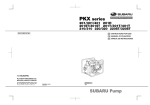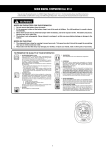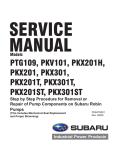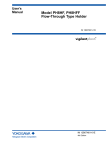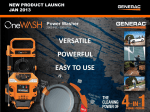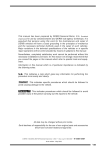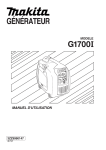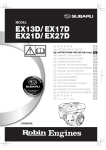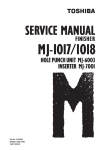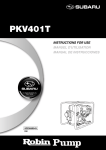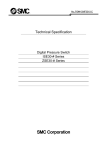Download Subaru Robin Power Products PKX Series Robin Pump 301 User's Manual
Transcript
PKX series 201/301/401 201H 201ST/301ST 201T/301T ISSUE EMD-PU2117 9ZZ9990035 1 PKX201,301,401, 201H, 201ST, 301ST 5 1 6 4 2 3 1 1 5 PKX201T, 301T 2 7 1 8 5 2 7 3 2 2 2 1 6 4 2 18 9 17 5 6 3 2 16 1 3 15 5W 10 14 20W Single grade 13 19 12 20 23 22 24 1 #40 Ambient temperature 7 3 7 #30 8 11 1 4 #20 10W-30 Multi grade 21 3 10W 10W-40 -20 -10 0 10 20 30 -4 14 32 50 68 86 104 F 40 C 4 5 8 4 1 2 PKX201T, 301T 5 4 6 1 2 3 7 0.6 - 0.7 mm 2 8 5 3 6 1 2 2 6 1 PKX201,301,401, 201H 201ST, 301ST 7 1 10 20 9 11 8 2 1 2 12 6 3 19 4 18 1 3 17 13 16 21 15 22 14 4 5 6 1 4 7 4 2 1 23 24 25 26 3 FOREWORD This manual covers operation and maintenance of ROBIN PUMP. All information in this publication is based on the latest product information available at the time of approval for printing. Please read this manual carefully before operating. Please take a moment to familiarize yourself with the proper operation and maintenance procedures in order to maximize the safe and efficient use of this product. ENGLISH Thank you very much for purchasing a ROBIN PUMP. Keep this owner’s manual at hand, so that you can refer to it at any time. Due to constant efforts to improve our products, certain procedures and specifications are subjected to change without notice. When ordering spare parts, always give us the MODEL, PRODUCTION NUMBER and SERIAL NUMBER of your pump. FRANÇAISE Please fill in the following blanks after checking the production number on your pump. (Location of label is different depending on the pump specification.) SER No. ESPAÑOL PROD No. PROD No. / SER No. Label SER No. Stamping CONTENTS Page 1. SAFETY PRECAUTIONS................................................................................... 2 2. COMPONENTS .................................................................................................. 5 3. PRE-OPERATION FOR STARTING .................................................................. 6 4. OPERATING YOUR PUMP ................................................................................ 7 5. MAINTENANCE ................................................................................................. 7 6. PREPARATIONS FOR STORAGE ..................................................................... 10 7. OIL SENSOR INSTRUCTIONS ............................................................................ 10 8. SPARK ARRESTER (OPTIONAL)...................................................................... 10 9. EASY TROUBLESHOOTING ............................................................................. 11 10. SPECIFICATIONS .............................................................................................. 12 NOTE Please refer to the illustrations on the back page of the front cover or back cover for Fig. 1 to i indicated in the sentence. Page 1 05.8.3, 7:11 PM 1. SAFETY PRECAUTIONS ENGLISH Please make sure you review each precaution carefully. Pay special attention to statement preceded by the following words. WARNING “WARNING” indicates a strong possibility of severe personal injury or loss of life if instructions are not followed. CAUTION “CAUTION” indicates a possibility of personal injury or equipment damage if instructions are not followed. WARNING : EXHAUST PRECAUTIONS FRANÇAISE Never inhale exhaust gasses. They contain carbon monoxide, a colorless, odorless and extremely dangerous gas which can cause unconsciousness or death. Never operate the pump indoors or in a poorly ventilated area, such as tunnel, cave, etc. Exercise extreme care when operating the pump near people or animals. Keep the exhaust pipe free of foreign objects. WARNING : REFUELING PRECAUTIONS Gasoline is extremely flammable and its vapors can explode if ignited. Do not refuel indoors or in a poorly ventilated area. Be sure to stop the pump prior to refueling. ESPAÑOL Do not remove fuel tank cap nor fill fuel tank while engine is hot or running. Allow engine to cool at least 2 minutes before refueling. Do not overfill the fuel tank. If fuel is spilt, wipe it away carefully and wait until the fuel has dried before starting the engine. After refueling, make sure that the fuel cap is secured to prevent spillage. WARNING : FIRE PREVENTION Do not operate the pump while smoking or near an open flame. Do not use around dry brush, twigs, cloth rags, or other flammable materials. Keep cooling air intake (recoil starter area) and muffler side of the engine at least 1 meter (3 feet) away from buildings, obstructions and other burnable objects. Keep the pump away from flammables and other hazardous materials (trash, rags, lubricants, explosives). 1m WARNING : OTHER SAFETY PRECAUTIONS Be careful of hot parts. The muffler and other engine parts become very hot while the pump is running or just after it has stopped. Operate the pump in a safe area and keep children away from the running pump. Do not use diaphram pump for the mixture of water and oil. Page 2 05.8.3, 7:11 PM 1m Operate the pump on a stable, level surface. If the engine is tilted, fuel spillage may result. NOTE Operating the pump at a steep incline may cause seizure due to improper lubrication even with a maximum oil level. ENGLISH Do not touch the spark plug and ignition cable when starting and operating the engine. Do not transport the pump with fuel in tank or with fuel strainer cock open. Keep the unit dry (do not operate it in rainy conditions). : PRE-OPERATION CHECKS Carefully check fuel hoses and joints for looseness and fuel leakage. Leaked fuel creates a potentially dangerous situation. Check bolts and nuts for looseness. A loose bolt or nut may cause serious engine trouble. Check the engine oil and refill if necessary. FRANÇAISE CAUTION Check the fuel level and refill if necessary. Take care not to overfill the tank. Keep cylinder fins and recoil starter free of dirt, grass and other debris. Wear snug fitting working clothes when operating the engine. ESPAÑOL Loose aprons, towels, belt, etc., may be caught in the engine or drive train, causing a dangerous situation. Page 3 05.8.3, 7:11 PM ENGLISH SYMBOLS Read the owner's manual. Stay clear of the hot surface. Exhaust gas is poisonous. Do not operate in an unventilated area. ESPAÑOL FRANÇAISE Stop the engine before refueling. Fire, open flame and smoking prohibited. On (Run) Plus ; Positive polarity Off (Stop) Battery Engine oil Engine start (Electric start) Add oil Page 4 05.8.3, 7:11 PM 2. COMPONENTS CENTRIFUGAL PUMP (PKX201,301,401,201H) SEMI TRASH PUMP (PKX201ST,301ST) q) (See Fig. 1-q q Plug (drain) !0 Casing cover !9 Strainer w Suction !1 Drain plug (at two places) @0 Cushion rubber e Delivery !2 Stop Switch @1 Hose coupling r Frame !3 Recoil starter @2 Hose band t Plug (priming) !4 Recoil Starter handle @3 Tools y Muffler !5 Fuel cock @4 Instruction for use u Spark plug !6 Chocke lever i Oil filler (with oil guage) !7 Air cleaner o Fuel tank !8 Speed control lever (This publication) FRANÇAISE NOTE Please refer to the illustrations on the back page of the front cover or back cover for Fig. 1 to i indicated in the sentence. ENGLISH (See Fig. 1) q Plug (drain) !1 Fuel tank @1 Strainer w Casing !2 Delivery @2 Cushion rubber e Suction !3 Knob @3 Hose coupling r Frame !4 Oil filler (with oil guage) @4 Hose band t Plug (priming) !5 Stop switch @5 Tools y Muffler !6 Recoil Starter @6 Instruction for use u Air cleaner !7 Recoil Starter handle i Spark plug !8 Fuel cock (This publication) o Drain plug (at two places) !9 Chocke lever !0 Casing cover @0 Speed control lever Page 5 05.8.3, 7:11 PM ESPAÑOL TRASH PUMP (PKX201T, 301T) w) (See Fig. 1-w 3. PRE-OPERATION FOR STARTING ENGLISH (See Fig. 2) 1. CONNECT SUCTION HOSE q) (See Fig. 2-q 4. CHECK FUEL t) (See Fig. 2-t Use a reinforced-wall or wire braided hose to prevent suction collapse. Since the pump self-priming time is directly proportional to hose length, a short hose is recommended. WARNING Do not refuel while smoking, near an open flame or other such potential fire hazards. Otherwise fire accident may occur. CAUTION FRANÇAISE Always use a strainer with the suction hose. Gravel or debris sucked into the pump will cause serious damage to the impeller and the pump casting. Use automotive unleaded gasoline only. This engine is certified to operate on automotive unleaded gasoline. Fuel Tank Capacity 2. CONNECT DELIVERY HOSE w) (See Fig. 2-w Refer to “10. SPECIFICATIONS” Page 12 for fuel tank capacity Close the fuel cock before filling the fuel tank. When using a fabric hose, always use a hose band to prevent the hose from disconnecting under high pressure. Do not fill above the top of the fuel filter screen (marked w), or the fuel may overflow when it heats up later and expands. When filling the fuel tank, always use the fuel filter screen. r) 3. CHECK ENGINE OIL (See Fig. 2-r Before checking or refilling engine oil, be sure the engine is located on stable, level surface and stopped. Do not screw the oil gauge into the oil filler neck to check oil level. If the oil level is low, refill to the upper level with the following recommended oil. ESPAÑOL Stop the engine and open the cap. Use 4-stroke automotive detergent oil of API service class SE or higher grade (SG, SH or SJ is recommended). Select the viscosity based on the air temperature at the time of operation as shown in the table. (See Fig.2 e) 2-r r Explanation of Fig.2 Wipe off any spilled fuel before starting the engine. (See Fig.2 y) 5. CHECK PRIMING WATER u) (See Fig. 2-u It is recommended that the water chamber of pump casing should be primed with full of water before operating. WARNING Never attempt to operate the pump without priming water or the pump will overheat. Extended dry operation will destroy the mechanical seal. If the unit has been operated dry, stop the engine immediately and allow the pump to cool before adding priming water. q Oil Gauge w Upper Level e Lower Level Model Oil capacity PKX201, PKX301, PKX201H, PKX201ST, PKX301ST, PKX201T 0.6L PKX401, PKX301T 1.1L Page 6 05.8.3, 7:11 PM 4. OPERATING YOUR PUMP (2) Turn the STOP SWITCH to the position “ I ” (ON). (See Fig.3-w) (1) Set the speed control lever at the low speed position and allow the engine to run at low speed for 1 or 2 minutes before stopping. (See Fig.5-q) (3) Set the speed control lever 1/3 of the way towards the high speed position. (See Fig.3-e) (2) Turn the STOP SWITCH counterclockwise to the position “ ” (OFF). (See Fig.5-w) (4) Close the choke lever. (See Fig.3-r) If the engine is cold or the ambient temperature is low, close the choke lever fully. If the engine is warm or the ambient temperature is high, open the choke lever half-way, or keep it fully open. (5) Pull the starter handle slowly until resistance is felt. This is the “compression” point. Return the handle to its original position and pull swiftly. Do not pull out the rope all the way. After starting the engine, allow the starter handle to return to its original position while still holding the handle. (See Fig.3 t) (6) After starting the engine, gradually open choke by turning the choke lever and finally keep it fully opened. Do not fully open the choke lever immediately when the engine is cold or the ambient temperature is low, because the engine may stop. (See Fig.3 y) 2. RUNNING (See Fig. 4) (1) After the engine starts, set the speed control lever at the low speed position (L) and warm it up without load for a few minutes. (See Fig.4-q) (2) Gradually move the speed control lever toward the high speed position (H) and set it at the required engine speed. (See Fig.4-w) Whenever high speed operation is not required, slow the engine down (idle) by moving the speed control lever to save fuel and extend engine life. (3) Close the fuel cock. (See Fig.5-e) (4) Pull the starter handle slowly and return the handle to its original position when resistance is felt. This operation is necessary to prevent outside moist air from intruding into the combustion chamber. (See Fig.5 r) STOPPING ENGINE WITH THE FUEL COCK Close the fuel cock and wait for a while until the engine stops. Avoid to let the fuel remain in the carburator over long periods, or the passages of the carburator may become clogged with impurities, and malfunctions may result. 5. MAINTENANCE (See Fig. 6) MAINTENANCE, REPLACEMENT OR REPAIR OF THE EMISSION CONTROL DEVICES AND SYSTEMS MAY BE PERFORMED BY ANY NONROAD ENGINE REPAIR ESTABLISHMENT OR INDIVIDUAL. 1. DAILY INSPECTION Before running the engine, check the following service items. q Loose or broken bolts and nuts w Clean air cleaner element e Enough clean engine oil r Leakage of gasoline and engine oil t Enough gasoline y Safe surroundings u Check the priming water i Excessive vibration, noise Page 7 FRANÇAISE (1) Open the fuel cock. (See Fig.3-q) ENGLISH 3. STOPPING (See Fig. 5) 05.8.3, 7:11 PM ESPAÑOL 1. STARTING (See Fig. 3) ENGLISH 2. PERIODIC INSPECTION Periodic maintenance is vital to the safe and efficient operation of your pump. Check the table below for periodic maintenance intervals. IT IS ALSO NECESSARY FOR THE USER OF THIS PUMP TO CONDUCT THE MAINTENANCE AND ADJUSTMENTS ON THE EMISSION-RELATED PARTS LISTED BELOW TO KEEP THE EMISSION CONTROL SYSTEM EFFECTIVE. The maintenance schedule indicated in the following table is based on the normal engine operation. Should the engine be operated in extremely dusty condition or in heavier loading condition, the maintenance intervals must be shortened depending on the contamination of oil, clogging of filter elements, wear of parts, and so on. CAUTION The emission control system consists of the following parts : (1) Carburetor and internal parts Replace rubber pipes for fuel passage every two years. If fuel leakage is found, replace the pipe immediately. (2) Cold start enrichment system, if applicable (3) Intake manifold, if applicable FRANÇAISE (4) Air cleaner elements (5) Spark plug (6) Magneto or electronic ignition system (7) Spark advance/ retard system, if applicable (8) Exhaust manifold, if applicable. (9) Hoses, belts, connectors, and assembles Periodic Maintenance Schedule table Every 8 hours (Daily) ESPAÑOL Maintenance items Every 50 hours (Weekly) CLEAN ENGINE AND CHECK BOLTS AND NUTS (Daily) CHECK AND REFILL ENGINE OIL (Refill daily up to upper level) CHANGE ENGINE OIL (*Note 1) (Initial 20 hours) CLEAN SPARK PLUG Every 200 hours (Monthly) Every 500 hours Every 1000 hours (Every 100 hours) (Every 100 hours) CLEAN AIR CLEANER REPLACE AIR CLEANER ELEMENT CLEAN FUEL CUP CLEAN AND ADJUST SPARK PLUG AND ELECTRODES REPLACE SPARK PLUG SPARK ARRESTER (OPTIONAL PART) (Every 100 hours) REMOVE CARBON FROM CYLINDER HEAD (*Note 2) CHECK AND ADJUST VALVE CLEARANCE (*Note 2) CLEAN AND ADJUST CARBURETOR (*Note 2) REPLACE FUEL LINES (yearly) OVERHAUL ENGINE IF NECESSARY (*Note 2) *Note: 1. Initial oil change should be performed after first twenty (20) hours of operation. Thereafter change oil every hundred (100) hours. Before changing oil, check for a suitable way to dispose of old oil. Do not pour it down into sewage drains, onto garden soil or into open streams. Your local zoning or environmental regulations will give you more detailed instructions on proper disposal. *Note: 2. As to the procedures for these items, please refer to the SERVICE MANUAL or consult your nearest Robin service dealer. Page 8 05.8.3, 7:11 PM (2) Check electrode gap. The gap should be 0.6 mm to 0.7 mm. Adjust the gap, if necessary, by carefully bending the side electrode. Recommended Spark Plug : NGK BR-6HS (CHAMPION RL86C) w,e e) 4. ENGINE OIL CHANGE (See Fig. 7-w Initial oil change Thereafter : After 20 hours of operation : Every 100 hours of operation (1) When changing oil, stop the engine and loosen the drain plug. Drain the used oil while the engine is warm. Warm oil drains quickly and completely. CAUTION A dirty air cleaner element will cause starting difficulty, power loss, engine malfunctions, and shorten engine life extremely. Always keep the air cleaner element clean. WARNING Flame Prohibited (1) Urethane Foam Element Type (See Fig.7 t) Remove the element and wash it in kerosene or diesel fuel. Then saturate it in a mixture of 3 parts kerosene or diesel fuel and 1 part engine oil. Squeeze the element to remove the mixture and install it in the air cleaner. (2) Urethane Foam Dual Element Type (See Fig.7 y) Urethane Foam cleaning (See Fig.7 y w) To prevent injury, pay attention to the hot oil. Make sure the fuel cap is tightly secured to avoid spillage. ENGLISH (1) Clean off carbon deposits on the spark plug electrode using a plug cleaner or wire brush. 6. CLEANING AIR CLEANER 7-t t,y y) (See Fig.7 Wash and clean the urethane foam with detergent. After cleaning, dry it. Clean the urethane foam element every 50 hours. FRANÇAISE 3. INSPECTING THE SPARK PLUG q) 7-q (See Fig.7 Second element (See Fig.7 y q) Clean by tapping gently to remove dirt and blow off dust. Never use oil. Clean the paper element every 50 hours of operation, and replace element set every 200 hours. Model Oil capacity PKX201, PKX301, PKX201H, PKX201ST, PKX301ST, PKX201T 0.6L Clean and replace air cleaner elements more often when operating in dusty environments. PKX401, PKX301T 1.1L 7-u u) 7. FUEL HOSE REPLACEMENT (See Fig.7 (3) Refer to page 6 for the recommended oil. Always use the best grade and clean oil. Contaminated oil, poor quality oil and shortage of oil cause damage to engine or shorten the engine life. r) 5. CLEANING FUEL CUP (See Fig. 7-r WARNING Flame Prohibited WARNING Take extreme caution when replacing fuel hose ; gasoline is extremely flammable. Replace the fuel hose every 1,000 hours or every year. If fuel leaks from fuel hose, replace the fuel hose immediately. 8. CHECKING BOLTS, NUTS AND SCREWS (1) Inspect fuel cup for water and dirt. (See Fig.7 r q) Retighten loose bolts and nuts. (2) To remove water and dirt, close the fuel cock and remove the fuel cup. Replace damaged parts with new ones. (3) After removing dirt and water, wash the fuel cup with kerosene or gasoline. Reinstall securely to prevent leakage. Page 9 Check for fuel and oil leaks. 9. CLEANING PUMP INSIDE Turn the knob counterclockwise and open the casing cover holder. Pull the casing toward you, and then remove the casing and the inner casing. Clean the inside of pump casing and casing cover with clean water. 05.8.3, 7:11 PM ESPAÑOL (2) Re-install the drain plug before refilling oil. 6. PREPARATIONS FOR STORAGE 8. SPARK ARRESTER (OPTIONAL) q) 8-q 1. WATER (See Fig.8 1. SPARK ARRESTER ENGLISH Drain all water from the drain plug. CAUTION When retightening drain plug, be sure to clean the drain plug and the thread of casing. Otherwise, the thread may be damaged. 2. DISCONNECT THE DELIVERY HOSE The spark arrester must be cleaned regularly to keep it functioning as designed. A clogged spark arrester: Tilt the pump and drain all water from delivery hole. Severe damage to pump may result if water freezes in the pumping chamber. Prevents the flow of exhaust gas e) 8-e 3. DISCHARGE FUEL (See Fig.8 Increases fuel consumption WARNING FRANÇAISE In a dry or wooded area, it is recommendable to use the product with a spark arrester. Some areas require the use of a spark arrester. Please check your local laws and regulations before operating your product. Reduces engine output Makes starting difficult Flame Prohibited If you do not use the engine more than 1 month, discharge fuel to prevent gum in the fuel system and carburetor parts. Remove the strainer cup, place the strainer over a container and open the strainer cock to discharge fuel from the fuel tank. Remove the drain screw of the carburetor float chamber and discharge fuel. 8-r r) 4. ENGINE OIL (See Fig.8 Change the engine oil with fresh oil. If the engine has been running, the muffler and the spark arrester will be very hot. Allow the muffler to cool before cleaning the spark arrester. How to remove the spark arrester 1. Remove the flange bolts from the muffler cover and remove the muffler cover. 2. Remove the special screw from the spark arrester and remove the spark arrester from the muffler. ESPAÑOL Remove the spark plug, pour about 5 cc of engine oil into the cylinder, slowly pull the starter handle of the recoil starter 2 or 3 times, and reinstall the spark plug. MUFFLER COVER DEFLECTOR 5. CLEAN AND STORE Slowly pull the recoil starter handle until resistance is felt and leave it in that position. Clean the pump thoroughly with an oiled cloth, put the cover on, and store the pump indoors in a well ventilated, low humidity area. 7. OIL SENSOR INSTRUCTIONS (OPTIONAL) 1. FUNCTION OF OIL SENSOR The engine will stop automatically when the oil level falls below the safety limit. The engine cannot be started unless the level is raised above the prescribed limit. (See Fig.2-r) SPARK ARRESTER SCREEN MUFFLER SCREW Clean the spark arrester screen Use a brush to remove carbon deposits from the spark arrester screen. Be careful to avoid damaging the screen. The spark arrester must be free of breaks and holes. Replace the spark arrester if it is damaged. SPARK ARESSTER SCREEN 2. RESTARTING (1) Fill the crankcase with oil up to the proper level. (2) As for restarting and operating the engine, refer to section “4. OPERATING YOUR PUMP” on page 7. Check the wire connector from the engine. It must be connected securely to the wire from oil sensor. When selecting the engine oil, refer to page 6 for the recommended oil. Page 10 Install the spark arrester, and muffler protector in the reverse order of disassembly. 05.8.3, 7:11 PM 9. EASY TROUBLESHOOTING Sucking air at suction side. (Check piping at suction side.) Drop off engine output (Consult your nearest dealer.) Breakage of mechanical seal. (Consult your nearest dealer.) High suction lift (Lower.) Suction hose is too long or thin. (Use a thick hose in minimum length.) Leak of water from water passage. (Stop leaking.) Clogging of foreign substance in impeller. (Disassemble and clean.) Wear of impeller. Looseness of suction chamber. (Retighten) Strainer is clogged. (Clean.) Engine speed is too low. (Consult your nearest dealer.) 3. PUMP DOES NOT SELFPRIME. Suction of air at suction side. (Check piping at suction side.) Insufficient priming water inside pump casing (Prime fully.) Imperfect tightening of drain plug. (Tighten the plugs completely.) Engine speed is too low. (Consult your nearest dealer.) Sucking air from mechanical seal. (Consult your nearest dealer.) Perform the following checks before you take the pump to your Robin dealer. If you still have trouble after completing the checks, take the pump to your nearest Robin dealer. (1) Is there a strong spark across the electrode ? Is the stop switch at position “ I ” (ON)? Remove and inspect the spark plug. If the electrode is fouled, clean or replace it with new one. Remove the spark plug and connect it to the plug cap. Pull the starter handle while grounding spark plug against engine body. Try with a new spark plug if the spark is weak or there is no spark. The ignition system is faulty if there is no spark with a new spark plug. WARNING Wipe out spilled fuel carefully before testing. Place spark plug as far away from spark plug hole as possible. Do not hold spark plug by hand while pulling recoil starter. NOTE The engine with oil sensor will stop automatically when the oil level falls below the prescribed limit. Unless the oil level is raised above the prescribed limit, the engine will stop immediately after starting. (2) Is there enough compression? Pull the starter handle slowly and check if resistance is felt. If little force is required to pull the starter handle, check if the spark plug is tightened firmly. If the spark plug is loose, tighten it. (3) Is the spark plug wet with gasoline? Is the fuel cock opened? Choke (close choke lever) and pull the starter handle five or six times. Remove the plug and check if its electrode is wet. If the electrode is wet, fuel is well supplied to your engine. When the electrode is dry, check where the fuel stops. (Check the fuel intake of the carburetor.) In case the engine does not start with well supplied fuel, try using fresh fuel. Page 11 ENGLISH 2. PUMPING VOLUME IS SMALL. 4. WHEN ENGINE DOES NOT START : FRANÇAISE Engine dose not start. (See 9.-4 “4. WHEN ENGINE DOES NOT START”) Sticking of impeller (Disassemble and clean.) 05.8.3, 7:11 PM ESPAÑOL 1. PUMP DOES NOT RUN . 10. SPECIFICATIONS MODEL PKX201 PKX301 Total Head m(ft) Maximum Delivery Volume Liter(U.S.gal) / min Suction Head m(ft) 80 x 80 (3 x 3) 100 x 100 (4 x 4) 50 x 50 (2 x 2) 80 x 80 (3 x 3) 30 (98) 31 (102) 27 (89) 30 (98) 28 (92) 600 (158) 970 (256) 1350 (356) 580 (153) 930 (246) 8 (26) 8 (26) 8 (26) 8 (26) 8 (26) EX13 Silicon - carbide EX17 Type EX13 EX27 EX17 Robin Air - Cooled, 4 - cycle, OHC, Gasoline Engine Lublicant ENGINE PKX301ST Self-priming, Semi Trash pump Ceramic - carbon Model Oil Capacity Automotive detergent oil (API / SE or higher grade, SEA / 10W-30 etc.) 0.6 (0.16) Liter (U.S.gal) 1.1 (0.29) 0.6 (0.16) Automotive unleaded gasoline Fuel Fuel Tank Capacity Liter (U.S.gal) 2.7 (0.71) 3.6 (0.95) 6.1(1.61) Spark plug 2.7 (0.71) 3.6 (0.95) NGK BR-6HS (CHAMPION RL86C) Starting system Dimensioms (L x W x H) Recoil starter mm (in.) Net Weight kg (lb) 486x357x399 (18.43x14.06x15.71) 24 (52.91) 505x387x467 (19.88x15.24x18.39) 650x457x645 (25.59x17.99x25.39) 468x357x399 (18.43x14.06x15.71) 505x387x467 (19.88x15.24x18.39) 30 (66.14) 51 (112.44) 25 (55.12) 31 (68.34) Standard accessories Engine tool kit (1set), Strainer (1pc.), Cussion rubber (1set), Hose band (3pcs.) Valve Clearance (Intake and Exhaust) 0.12 +0.03 mm (0.0047 +0.0012 in.) 0 0 Note : Adjust the valve clearance while the engine is cold. Emissions Durability Period (California only) MODEL 500 hours PKX201T Type PUMP Total Head m(ft) Maximum Delivery Volume Liter(U.S.gal) / min Suction Head m(ft) 50 x 50 (2 x 2) PKX201H Self-priming, Centrifugal High Water pump 80 x 80 (3 x 3) 50 x 50 (2 x 2) 29 (95) 25 (82) 57 (187) 700 (185) 1190 (314) 480 (127) 8 (26) 8 (26) Axle Seal Material (Mechanical Seal) 8 (26) Silicon - carbide EX17 Model Ceramic - carbon EX27 EX17 Robin Air - Cooled, 4 - cycle, OHC, Gasoline Engine Type Automotive detergent oil (API / SE or higher grade, SEA / 10W-30 etc.) Lublicant Oil Capacity PKX301T Self-priming, Trash pump Suction x Delivery Diameters mm(in.) ENGINE ESPAÑOL PKX201ST 50 x 50 (2 x 2) Axle Seal Material (Mechanical Seal) FRANÇAISE PKX401 Self-priming, Centrifugal pump Suction x Delivery Diameters mm(in.) PUMP ENGLISH Type Liter (U.S.gal) 0.6 (0.16) Fuel Fuel Tank Capacity Liter (U.S.gal) 3.6 (0.95) Spark plug Net Weight 0.6 (0.16) 3.6 (0.95) 6.1(1.61) NGK BR-6HS (CHAMPION RL86C) Starting system Dimensioms (L x W x H) 1.1 (0.29) Automotive unleaded gasoline Recoil starter mm (in.) kg (lb) 620x462x481 (24.1x18.19x18.94) 690x485x537 (27.17x19.09x21.14) 520x390x434 (20.47x15.35x17.09) 48 (105.82) 58 (127.87) 32 (70.55) Standard accessories Engine tool kit (1set), Strainer (1pc.), Cussion rubber (1set), Hose band (3pcs.) Valve Clearance (Intake and Exhaust) 0.12 +0.03 mm (0.0047 +0.0012 in.) 0 0 Note : Adjust the valve clearance while the engine is cold. Emissions Durability Period (California only) 500 hours Page 12 05.8.3, 7:11 PM PKX series 201/301/401 201H 201ST/301ST 201T/301T ISSUE EMD-PU2117 9ZZ9990035















